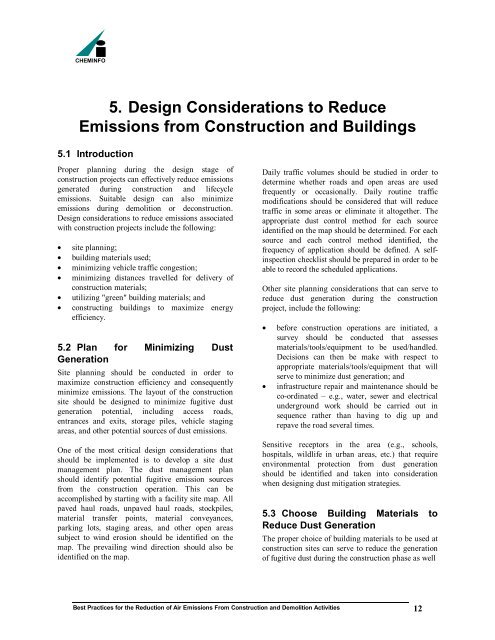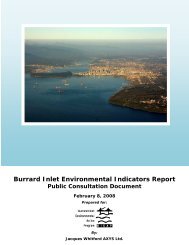Best Practices for the Reduction of Air Emissions From Construction ...
Best Practices for the Reduction of Air Emissions From Construction ...
Best Practices for the Reduction of Air Emissions From Construction ...
Create successful ePaper yourself
Turn your PDF publications into a flip-book with our unique Google optimized e-Paper software.
CHEMINFO<br />
5. Design Considerations to Reduce<br />
<strong>Emissions</strong> from <strong>Construction</strong> and Buildings<br />
5.1 Introduction<br />
Proper planning during <strong>the</strong> design stage <strong>of</strong><br />
construction projects can effectively reduce emissions<br />
generated during construction and lifecycle<br />
emissions. Suitable design can also minimize<br />
emissions during demolition or deconstruction.<br />
Design considerations to reduce emissions associated<br />
with construction projects include <strong>the</strong> following:<br />
• site planning;<br />
• building materials used;<br />
• minimizing vehicle traffic congestion;<br />
• minimizing distances travelled <strong>for</strong> delivery <strong>of</strong><br />
construction materials;<br />
• utilizing "green" building materials; and<br />
• constructing buildings to maximize energy<br />
efficiency.<br />
5.2 Plan <strong>for</strong> Minimizing Dust<br />
Generation<br />
Site planning should be conducted in order to<br />
maximize construction efficiency and consequently<br />
minimize emissions. The layout <strong>of</strong> <strong>the</strong> construction<br />
site should be designed to minimize fugitive dust<br />
generation potential, including access roads,<br />
entrances and exits, storage piles, vehicle staging<br />
areas, and o<strong>the</strong>r potential sources <strong>of</strong> dust emissions.<br />
One <strong>of</strong> <strong>the</strong> most critical design considerations that<br />
should be implemented is to develop a site dust<br />
management plan. The dust management plan<br />
should identify potential fugitive emission sources<br />
from <strong>the</strong> construction operation. This can be<br />
accomplished by starting with a facility site map. All<br />
paved haul roads, unpaved haul roads, stockpiles,<br />
material transfer points, material conveyances,<br />
parking lots, staging areas, and o<strong>the</strong>r open areas<br />
subject to wind erosion should be identified on <strong>the</strong><br />
map. The prevailing wind direction should also be<br />
identified on <strong>the</strong> map.<br />
Daily traffic volumes should be studied in order to<br />
determine whe<strong>the</strong>r roads and open areas are used<br />
frequently or occasionally. Daily routine traffic<br />
modifications should be considered that will reduce<br />
traffic in some areas or eliminate it altoge<strong>the</strong>r. The<br />
appropriate dust control method <strong>for</strong> each source<br />
identified on <strong>the</strong> map should be determined. For each<br />
source and each control method identified, <strong>the</strong><br />
frequency <strong>of</strong> application should be defined. A selfinspection<br />
checklist should be prepared in order to be<br />
able to record <strong>the</strong> scheduled applications.<br />
O<strong>the</strong>r site planning considerations that can serve to<br />
reduce dust generation during <strong>the</strong> construction<br />
project, include <strong>the</strong> following:<br />
• be<strong>for</strong>e construction operations are initiated, a<br />
survey should be conducted that assesses<br />
materials/tools/equipment to be used/handled.<br />
Decisions can <strong>the</strong>n be make with respect to<br />
appropriate materials/tools/equipment that will<br />
serve to minimize dust generation; and<br />
• infrastructure repair and maintenance should be<br />
co-ordinated – e.g., water, sewer and electrical<br />
underground work should be carried out in<br />
sequence ra<strong>the</strong>r than having to dig up and<br />
repave <strong>the</strong> road several times.<br />
Sensitive receptors in <strong>the</strong> area (e.g., schools,<br />
hospitals, wildlife in urban areas, etc.) that require<br />
environmental protection from dust generation<br />
should be identified and taken into consideration<br />
when designing dust mitigation strategies.<br />
5.3 Choose Building Materials to<br />
Reduce Dust Generation<br />
The proper choice <strong>of</strong> building materials to be used at<br />
construction sites can serve to reduce <strong>the</strong> generation<br />
<strong>of</strong> fugitive dust during <strong>the</strong> construction phase as well<br />
<strong>Best</strong> <strong>Practices</strong> <strong>for</strong> <strong>the</strong> <strong>Reduction</strong> <strong>of</strong> <strong>Air</strong> <strong>Emissions</strong> <strong>From</strong> <strong>Construction</strong> and Demolition Activities 12
















